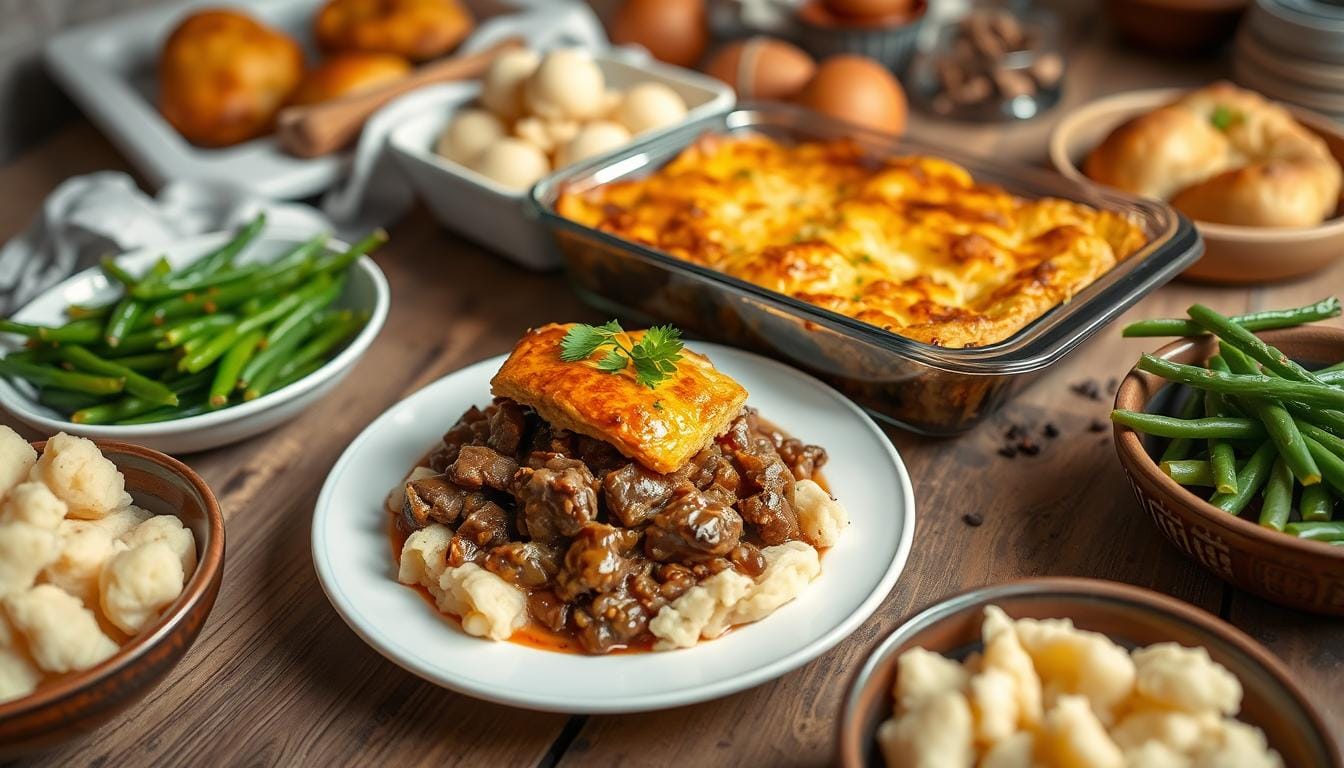Delicious Beef Casserole: Easy Weeknight Meal
Every busy family faces the challenge of making a tasty meal after a long day. The beef casserole is my go-to for turning chaotic weeknights into cozy moments. It’s not just a meal; it’s a way to ease dinnertime stress and bring warmth to your kitchen.
When time is tight and hunger is strong, a classic beef casserole is a lifesaver. It turns simple ingredients into a hearty, unforgettable dinner. Imagine coming home to the inviting smell of a casserole baking in the oven.
Families all over the U.S. have found the joy of this versatile dish. Whether you’re new to cooking or experienced, this beef casserole recipe is easy and flavorful. It offers minimal prep for maximum satisfaction, making it a one-pot wonder.
Are you ready to make a meal that will become a family favorite? This guide will show you how to pick the best ingredients and cook techniques. Together, we’ll turn your weeknight dinners into something truly special.
Table of Contents
Why Beef Casserole Is the Perfect Comfort Food
Beef casserole is a favorite in many American homes. It brings warmth, nutrition, and ease in one dish. These hearty meals have been loved by cooks for years, turning simple ingredients into delicious dishes.
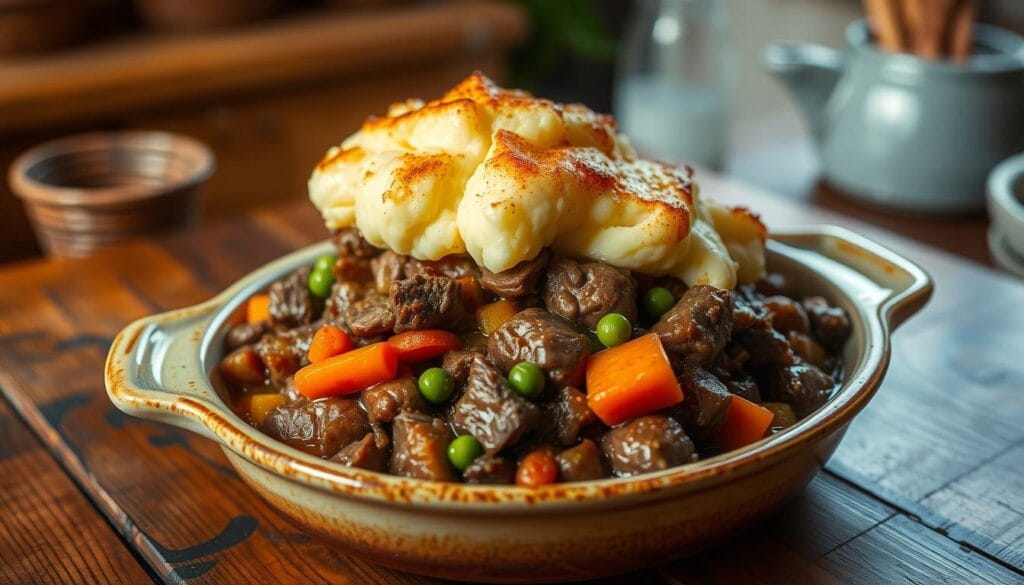
The History of Casserole Dishes
Casserole dishes started in France in the mid-19th century. They quickly became popular worldwide. The term “casserole” means a big, deep cooking pot in French. These dishes make it easy to cook nutritious meals with little effort.
“A good casserole is like a warm hug for your taste buds” – Julia Child
Health Benefits of One-Pot Meals
- Nutrient-dense cooking method
- Reduced use of additional fats
- Easy portion control
- Preserves vitamins and minerals
Time-Saving Benefits for Busy Families
| Benefit | Time Saved |
|---|---|
| Preparation Time | 30-45 minutes |
| Cleanup Time | 15-20 minutes |
| Total Cooking Process | 45-65 minutes |
For families on the go, casserole dishes are a big help. They let you mix many ingredients in one pot. This makes meal prep faster and creates tasty dinners that everyone enjoys.
Essential Ingredients for the Perfect Beef Casserole
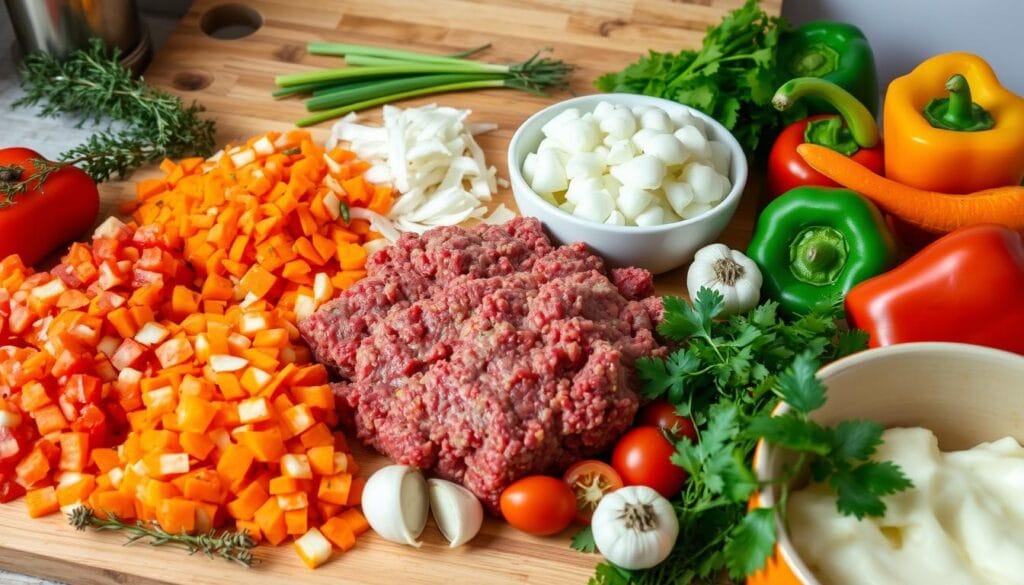
Starting with the right ingredients is key to making delicious casseroles. Your beef dishes will stand out if you pick each part carefully. This builds layers of flavor and texture.
The base of a great beef casserole is top-notch meat. Choose cuts that get tender and rich when cooked slowly.
- Chuck roast (best for tender, flavorful results)
- Beef stew meat
- Sirloin tip
Vegetables are also vital for adding depth to your beef recipes. Here are some good choices:
- Carrots
- Onions
- Celery
- Potatoes
| Ingredient Category | Purpose in Casserole | Recommended Quantity |
|---|---|---|
| Protein | Provides main flavor and texture | 1-2 pounds of beef |
| Vegetables | Adds nutrition and complexity | 2-3 cups mixed vegetables |
| Liquid Base | Creates moisture and rich sauce | 2-3 cups beef broth |
Seasoning makes a big difference in your casseroles. Salt, pepper, garlic powder, and herbs like thyme or rosemary can make your dish taste like it’s from a restaurant.
“The secret to an amazing beef casserole is layering flavors and allowing ingredients to meld together slowly.” – Professional Chef
Using fresh, quality ingredients is essential. This way, your beef recipes will be unforgettable and your family will ask for them again and again.
Kitchen Equipment You’ll Need
To make tasty baked beef dishes, you need the right tools. The right equipment makes cooking better and gets you the best results for your beef casserole.
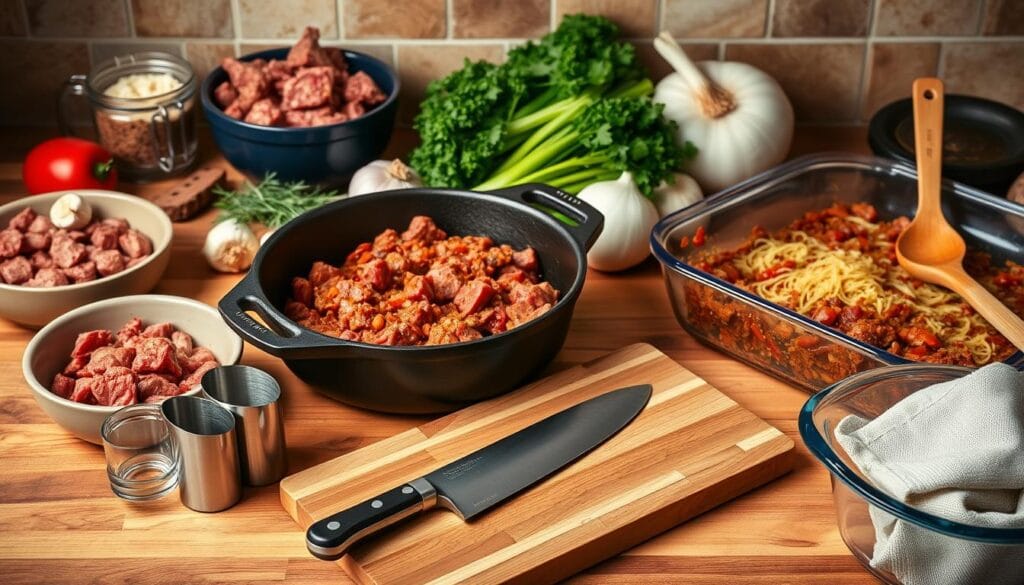
Recommended Casserole Dishes
Choosing the right casserole dish is key for perfect baked beef dishes. Here are some good options:
- Ceramic Casserole Dishes: They heat evenly and look great on your table
- Cast Iron Casseroles: They keep heat well and cook great
- Glass Baking Dishes: You can see how your dish is cooking and they’re easy to clean
Additional Cooking Tools
Make your baked beef dishes prep easier with these tools:
- Sharp chef’s knife for cutting meat
- Cutting board
- Measuring cups and spoons
- Wooden spoon or spatula
- Meat thermometer
Storage Containers
Good storage keeps your baked beef dishes fresh longer. Get high-quality containers:
| Container Type | Best For | Recommended Size |
|---|---|---|
| Airtight Glass Containers | Refrigerator Storage | 3-4 cup capacity |
| Freezer-Safe Plastic Containers | Long-term Freezing | 2-5 cup capacity |
| Vacuum Seal Bags | Maximum Preservation | Quart and Gallon sizes |
“The right equipment can turn a good recipe into an extraordinary meal.” – Professional Chef
Quality kitchen tools make your baked beef dishes stand out. Choose well and enjoy cooking!
Step-by-Step Preparation Guide
Making a tasty beef casserole is easy. This recipe will guide you through each step. Your family will love the delicious meal.
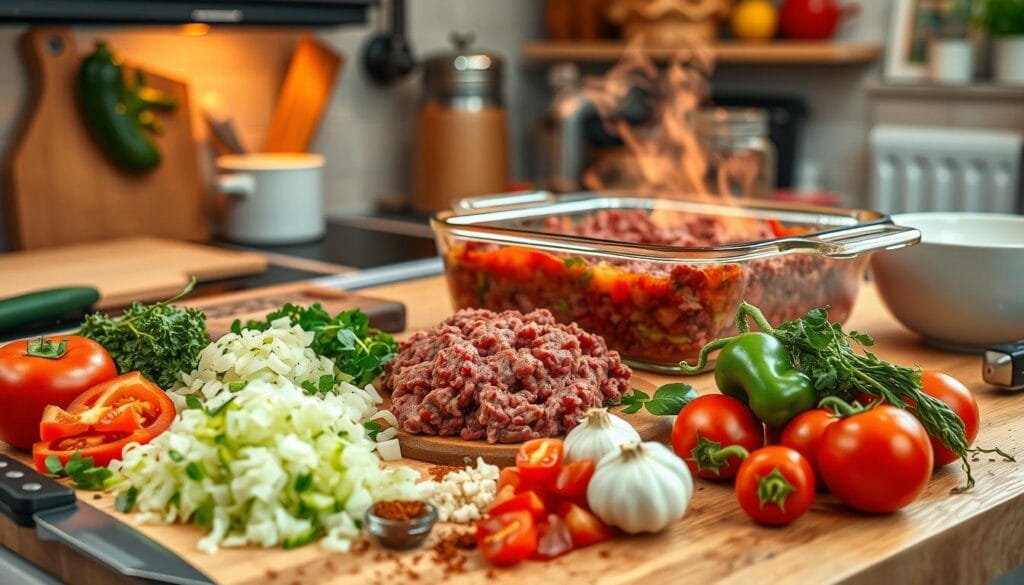
First, get all your ingredients and tools ready. Preparation is key for perfect beef recipes.
- Brown the beef in a large skillet over medium-high heat
- Drain excess fat to keep your casserole from becoming greasy
- Chop vegetables into uniform pieces for even cooking
- Layer ingredients strategically in your casserole dish
“The secret to a great beef casserole is in the layering and seasoning.” – Professional Chef
When you’re putting your beef casserole together, remember these important steps:
- Season meat generously with salt and pepper
- Use fresh herbs for enhanced flavor
- Mix ingredients gently to prevent toughening the meat
The final step is baking your easy beef casserole. Make sure your oven is at the right temperature for the best results.
| Preparation Stage | Time Required | Key Tips |
|---|---|---|
| Meat Preparation | 15 minutes | Brown thoroughly, drain fat |
| Vegetable Chopping | 10 minutes | Cut into uniform sizes |
| Layering | 5 minutes | Season each layer |
| Baking | 45-60 minutes | Cover with foil, check moisture |
Pro tip: Let your beef casserole rest for 10 minutes after baking. This lets the flavors settle and makes serving easier.
Best Cuts of Beef for Your Casserole
Choosing the right beef can make your casserole amazing. The meat’s flavor, tenderness, and taste all matter. Knowing about different cuts helps you pick the best for your budget and taste.
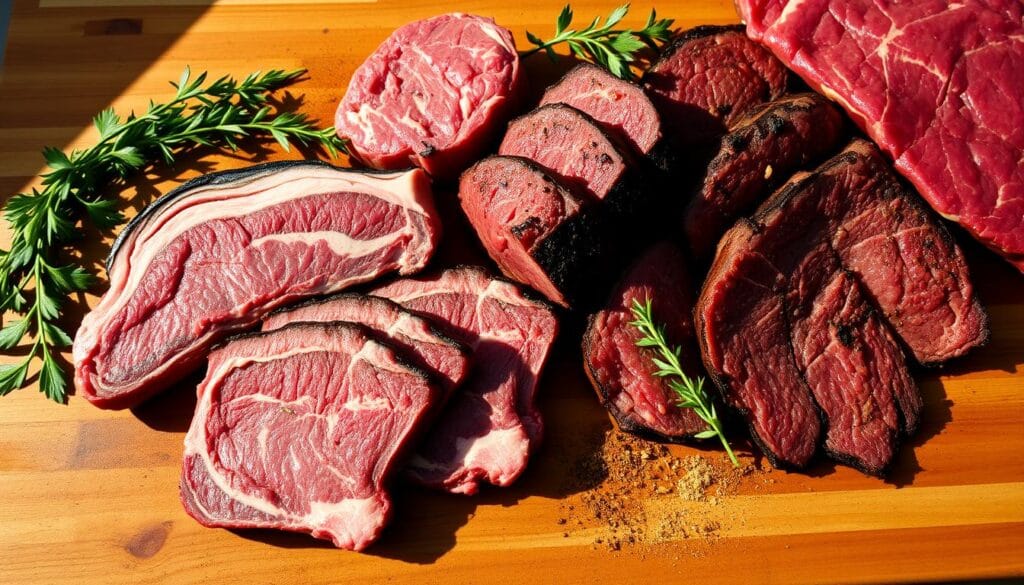
Budget-Friendly Beef Options
For a budget-friendly casserole, try these cuts:
- Chuck roast: Great for slow cooking
- Ground beef: Easy to use and cheap
- Bottom round: Lean and affordable
Premium Cuts for Special Occasions
For a fancy casserole, go for these premium cuts:
| Cut | Characteristics | Price Range |
|---|---|---|
| Ribeye | Rich marbling, intense flavor | High |
| Tenderloin | Extremely tender, mild taste | Very High |
| Sirloin | Balanced flavor, moderate tenderness | Medium |
Preparing Different Cuts
Getting your beef ready right is key. Tougher cuts need longer cooking times to soften. Ground beef casseroles cook faster because of the smaller pieces.
“The secret to a great casserole is patience and the right cut of beef.” – Professional Chef
Pro tip: Trim fat and cut meat evenly for even cooking. Browning the meat before adding makes the dish richer and more flavorful.
Seasoning and Flavor Enhancement Tips
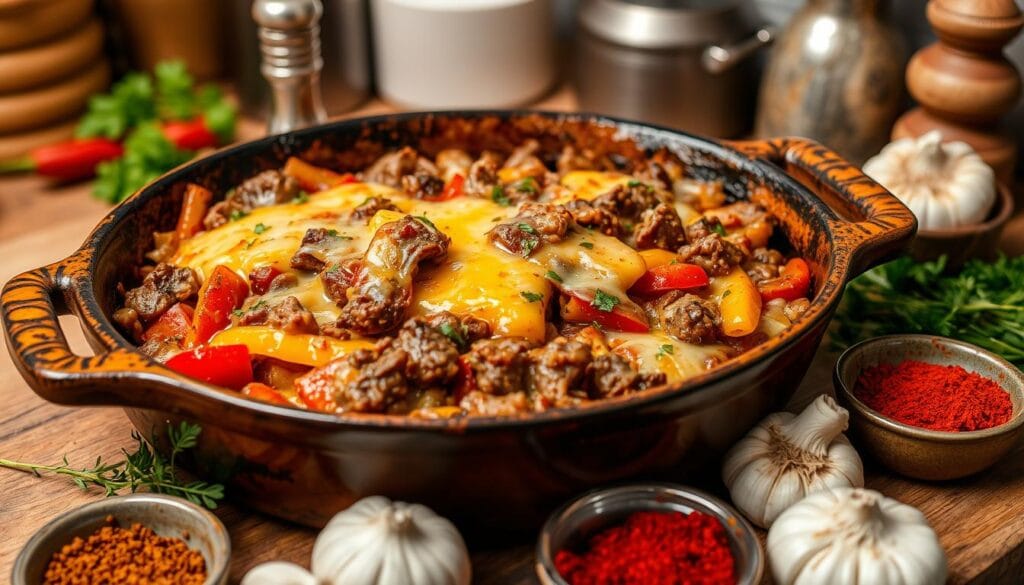
Improving your beef recipes means mastering seasoning. The right mix of herbs and spices can turn simple casseroles into unforgettable meals. Your family will ask for more.
Here are some tips to boost your beef casserole flavors:
- Use fresh herbs like rosemary, thyme, and oregano for depth
- Incorporate robust spices such as paprika and cumin
- Layer flavors with aromatics like garlic and onion
- Experiment with unexpected ingredients like red wine or balsamic vinegar
Professional chefs say complex flavors come from smart seasoning. Browning your beef before adding to the casserole creates a rich foundation that intensifies the overall taste profile.
“Great seasoning is the difference between a good meal and an unforgettable dish” – Chef Michael Roberts
Here’s a guide to help you improve your beef recipes:
| Seasoning Type | Flavor Profile | Best Used With |
|---|---|---|
| Fresh Herbs | Bright, Green | Lean Beef Cuts |
| Dried Spices | Warm, Intense | Fatty Beef Cuts |
| Liquid Seasonings | Complex, Deep | Slow-Cooked Casseroles |
Seasoning is an art. Don’t be shy to try new combinations. This will make your casseroles truly stand out.
Make-Ahead and Storage Instructions
Beef casserole is perfect for busy family dinners. It’s great to have meals ready when you need them. Here’s how to keep your casserole fresh and safe.
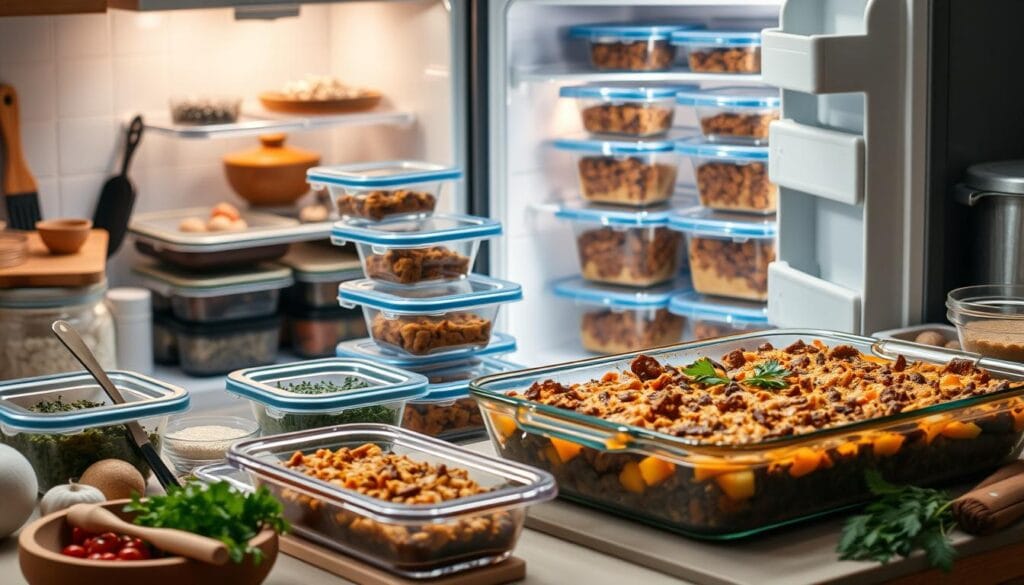
Freezing Guidelines
Freezing is a great way to save your meals for later. Follow these tips for the best results:
- Cool the casserole completely before freezing
- Use airtight, freezer-safe containers
- Label containers with the date and contents
- Freeze for up to 3 months
Reheating Methods
Reheating your casserole right is key to keeping its taste and texture. Here are some good ways to do it:
| Method | Temperature | Time |
|---|---|---|
| Oven | 350°F | 20-25 minutes |
| Microwave | Medium power | 3-4 minutes |
Food Safety Tips
Food safety is very important when you’re preparing and storing meals. Remember these tips:
- Always refrigerate within 2 hours of cooking
- Consume refrigerated casserole within 3-4 days
- Reheat to an internal temperature of 165°F
- Discard if any odd smell or appearance is noticed
“Good food is all about proper preparation and storage.” – Professional Chef
Pro tip: Divide large casseroles into smaller portions before freezing. This makes reheating easier and prevents unnecessary waste.
Common Mistakes to Avoid
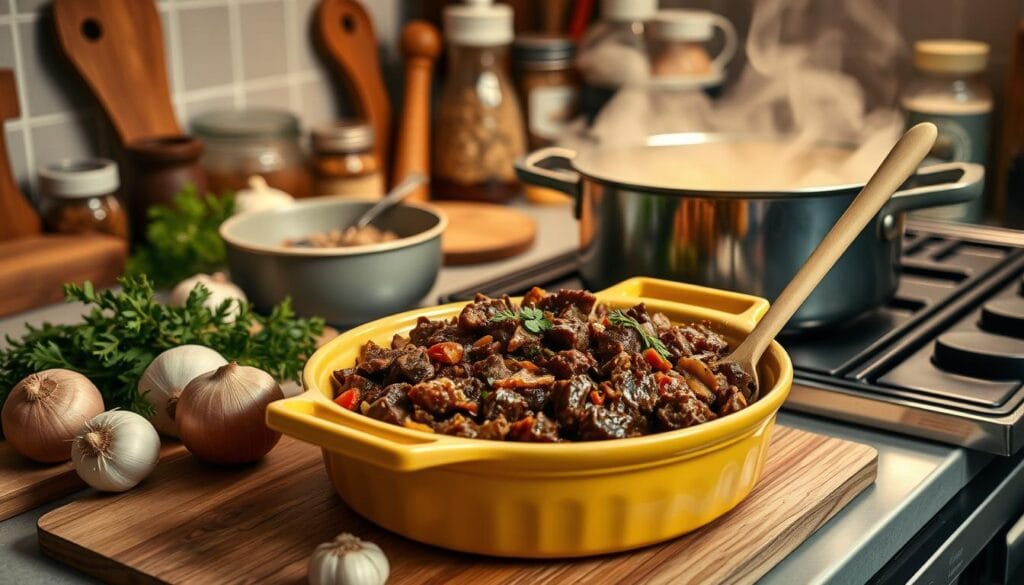
Making a tasty beef casserole can be challenging, even for skilled cooks. Knowing the common mistakes helps you make a dish that will wow your loved ones.
- Meat Selection Errors: The wrong beef cut can make your casserole tough. Choose braising cuts like chuck roast or short ribs for tender results.
- Seasoning Mistakes: Not seasoning enough is a common issue. Always taste and adjust your seasonings as you cook.
- Overcooking Concerns: Beef casseroles need careful temperature control to avoid dry meat.
Keeping the right temperature is key when cooking beef casserole. High heat can make the meat tough and dry. Use slow cooking to keep the beef tender and juicy.
“The secret to a perfect beef casserole is patience and proper technique.” – Professional Chef
Managing liquids is also vital for great casserole dishes. Too much liquid makes it too wet, while too little makes it dry. Find the right balance for tender, flavorful meat.
- Use fresh ingredients
- Select appropriate cooking vessels
- Monitor cooking time carefully
Avoiding these mistakes will make your beef casserole outstanding. It will become a favorite comfort meal for your family.
Variations and Customization Options
Exploring ways to make beef recipes your own is exciting. It turns classic comfort food into something unique. Every home cook wants to add their personal touch.
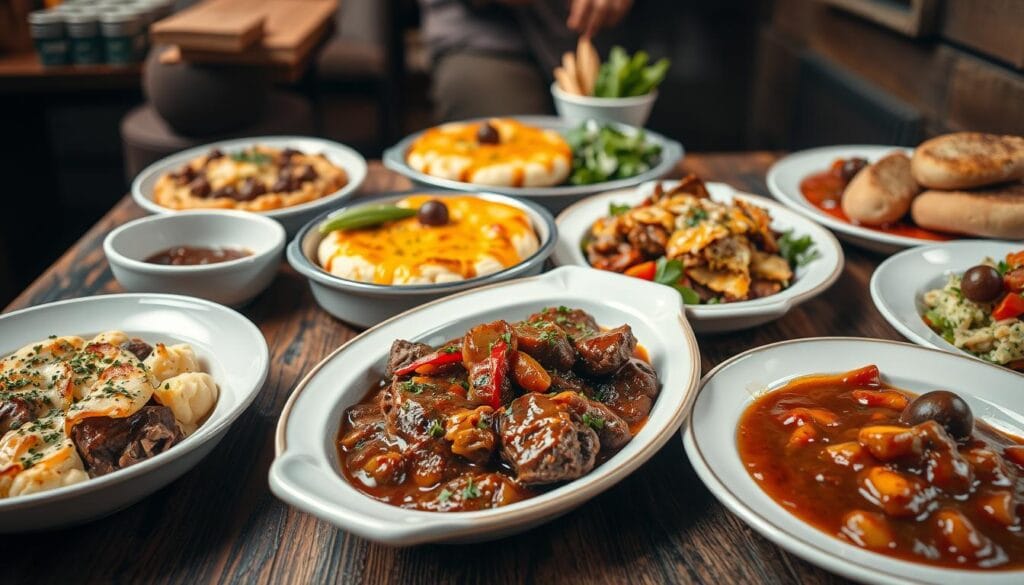
Low-Carb Alternatives
Want to enjoy beef casseroles without the carbs? Try these smart swaps:
- Replace potatoes with cauliflower rice
- Use zucchini noodles instead of pasta
- Swap breadcrumbs for crushed pork rinds
- Choose almond flour as a thickening agent
Vegetable Additions
Adding different veggies boosts nutrition and flavor. Here are some great options:
- Roasted bell peppers
- Spinach leaves
- Mushrooms
- Butternut squash
Spice Level Adjustments
Adjust the heat in your casseroles with these tips:
| Spice Level | Recommended Additions |
|---|---|
| Mild | Paprika, black pepper |
| Medium | Cayenne pepper, chili flakes |
| Hot | Jalapeños, habanero sauce |
“The beauty of beef casseroles is their incredible versatility!” – Professional Chef
Remember, trying new ingredients lets you make beef recipes that fit your taste and diet.
Serving Suggestions and Side Dishes
Make your beef casserole a memorable family dinner with the right side dishes. This classic comfort food needs sides that make the meal even better. They should please everyone at the table.
- Fresh Green Salads
- Crisp mixed greens
- Arugula with lemon vinaigrette
- Cucumber and tomato salad
- Bread and Grains
- Crusty French bread
- Garlic roasted dinner rolls
- Fluffy mashed potatoes
Pro tip: Choose sides that balance the casserole’s richness with lighter, refreshing elements.
“A great side dish can transform a good meal into an extraordinary family dinner.” – Home Cooking Wisdom
For family dinners, think about how you present the meal. Put your beef casserole in a pretty ceramic dish. Arrange your side dishes in matching bowls. This makes the meal feel special and welcoming.
Pairing your meal with wine like Cabernet Sauvignon or Merlot can make it feel like a fancy restaurant dinner. Enjoy a meal that’s both comforting and elegant.
Conclusion
Making a tasty beef casserole is more than cooking a meal. It’s about adding comfort and flavor to your dinner. This easy dish is perfect for busy families who want a hearty meal without spending hours cooking.
Your beef casserole journey is a chance to try new things. You can play with ingredients and flavors. It’s a dish that lets you show off your cooking skills, whether you’re experienced or just starting.
Remember, the more you make this dish, the better you’ll get. Don’t be shy to try new things and make it your own. The beauty of this meal is how easy it is to change and adapt.
Now it’s your turn to start cooking. Get your ingredients ready and make a beef casserole that your family will love. Your kitchen is ready for a tasty adventure!

